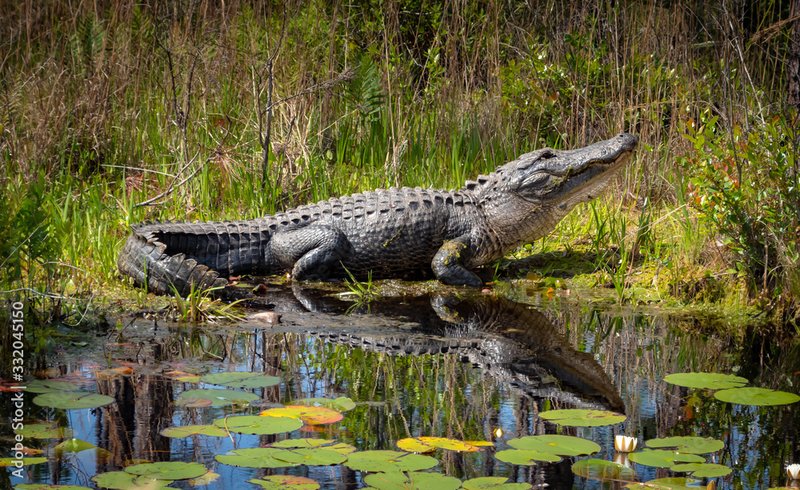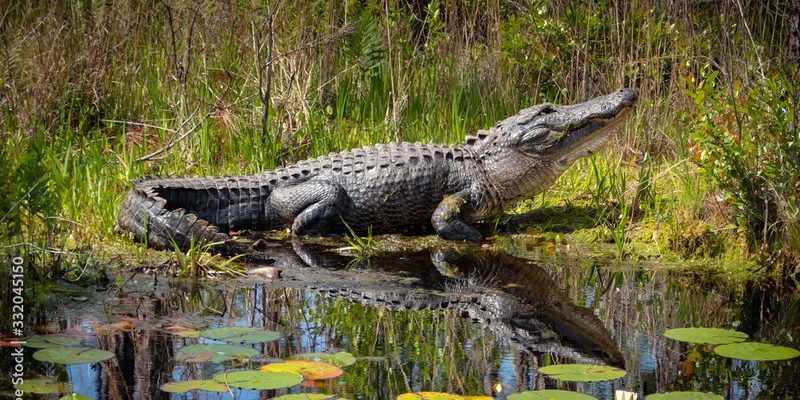
Think of identifying an American alligator as a treasure hunt—one filled with clues from nature. From their distinctive physical features to their behaviors in the wild, there are plenty of telltale signs to look for. Let’s break it down so you’ll feel ready to spot these incredible animals when you’re out exploring.
Physical Characteristics of American Alligators
When trying to identify an American alligator, their physical features are your best clues. First off, their size is hard to miss. Adult alligators typically range from 10 to 15 feet long, although some individuals can grow even larger. With a robust, armored body covered in tough, scaly skin, they embody strength. Think of them like living tanks in their swampy habitats.
Another key feature is their snout shape. American alligators have a broad snout that’s U-shaped, distinguishing them from the more V-shaped snouts of crocodiles. If you notice that unmistakable wide snout, you can confidently say you’re looking at an alligator. Their eyes are positioned high on their heads, which allows them to see above water while most of their body remains submerged.
Lastly, pay attention to their coloration. American alligators typically sport a dark, olive green or even a grayish black on their backs, while their underbellies are lighter, often yellowish or white. This coloration helps them blend beautifully into their murky habitats, making them harder to spot.
Behavioral Traits to Observe
Alligators have some fascinating behaviors that can help you identify them in the wild. One telltale sign is the way they bask in the sun. You might see them lounging on a log or riverbank. This sunbathing helps them regulate their body temperature. If you’re lucky enough to see one with its mouth open, this isn’t a sign of aggression; rather, it’s their way of cooling down!
Listen for their vocalizations as well. Male alligators can make a deep rumbling sound called bellowing, especially during mating season. It’s a bit like an old truck trying to start up—the sound can carry for miles! If you hear that rumble echoing across the water, you know there’s an alligator nearby.
Also, keep an eye out for their hunting techniques. Alligators are opportunistic feeders. They’re known to remain motionless in the water, creating a still surface, which can make it hard to spot them until it’s too late for their prey. That stealthy ambush style is part of what makes them such successful hunters.
Habitat and Range
Understanding where alligators live is key to spotting them. American alligators primarily inhabit freshwater environments. You’ll find them in rivers, lakes, swamps, and marshes throughout the southeastern United States. They like warm, shallow areas with plenty of vegetation.
A good way to approach their habitat is by looking for signs of alligator activity. This can include tracks along muddy banks, trails through the grass, or even their distinctive nests made out of vegetation. In places like Florida or Louisiana, you can check local wildlife management areas or state parks where alligators are often spotted.
If you’re ever near a body of water, keep your eyes peeled, especially in the early morning or late afternoon. Alligators are generally more active during these cooler hours, making them easier to see.
Signs of Presence: What to Look For
If you’re hoping to identify an American alligator but don’t see one, don’t fret. There are plenty of signs to look for. Tracks are a helpful clue since alligators leave distinctive marks in the mud. Their footprints are large, with unique webbing between their toes. If you see tracks leading to or from the water, an alligator has likely been in the area.
Another sign is sliding marks along riverbanks, which indicate where an alligator has entered or exited the water. These often appear as smooth areas in the mud or grass. Also, keep an ear out for splashes or disturbances in the water, which could indicate that an alligator is active.
And, of course, if you spot an alligator in the wild, pay attention to its facial features. Its eyes and nostrils will often be the only parts visible while it’s submerged, almost like a floating log. This clever adaptation enables them to remain hidden while they observe their environment.
Safety Tips When Observing Alligators
While spotting an American alligator is thrilling, it’s essential to observe safely. Always keep your distance—ideally at least 50 feet away. Give them space, as they can be unpredictable. Alligators are generally not aggressive towards humans unless provoked, but it’s best to stay cautious.
Avoid feeding them, as this can alter their natural behaviors and make them more accustomed to human presence. If you’re near water and see an alligator, back away slowly. Don’t approach it or take photos too close up. Use binoculars or a zoom lens to get a closer look without putting yourself in danger.
Lastly, be mindful of your surroundings. Keep pets on leashes and kids close to you. Trust your instincts—if something doesn’t feel right, it’s always best to move along to a safer spot.
Identifying an American alligator in the wild is an adventure filled with excitement and wonder. Each encounter can teach you something new about these ancient reptiles. By looking for their physical characteristics, noting their behaviors, and understanding their habits, you can turn a casual outing into a memorable wildlife experience.
Remember, it’s not just about spotting an alligator; it’s about appreciating the beauty of nature. So, the next time you find yourself near a swamp or a river, keep an eye out, enjoy the journey, and cherish the moments you spend in the company of one of nature’s most remarkable creatures. Happy exploring!

